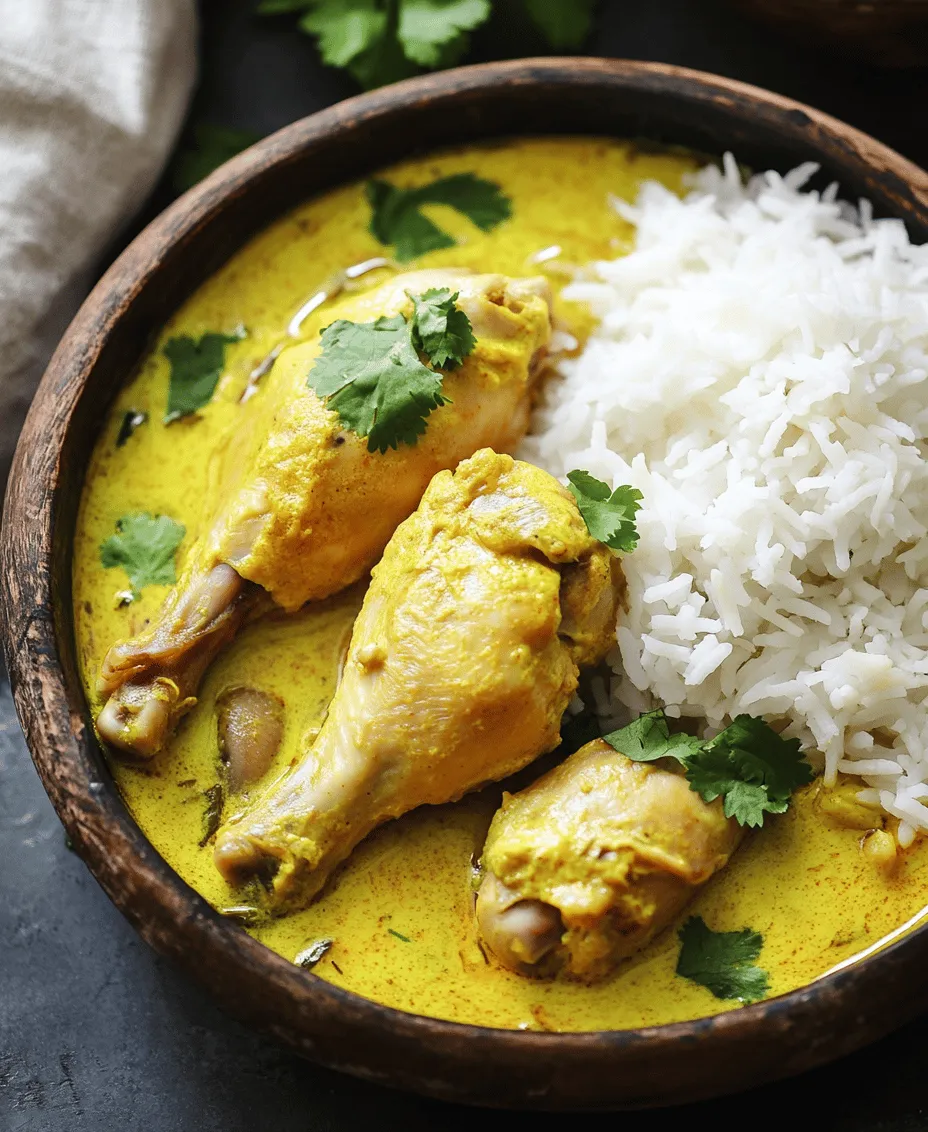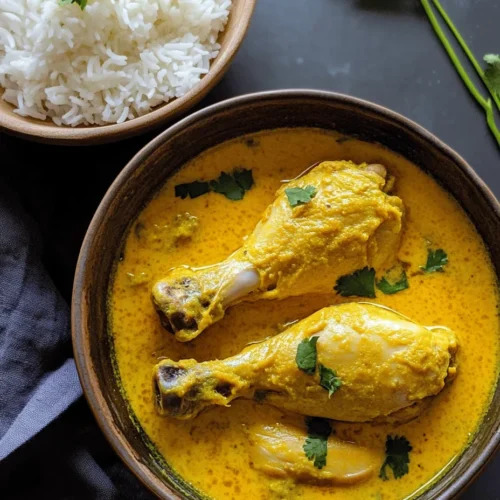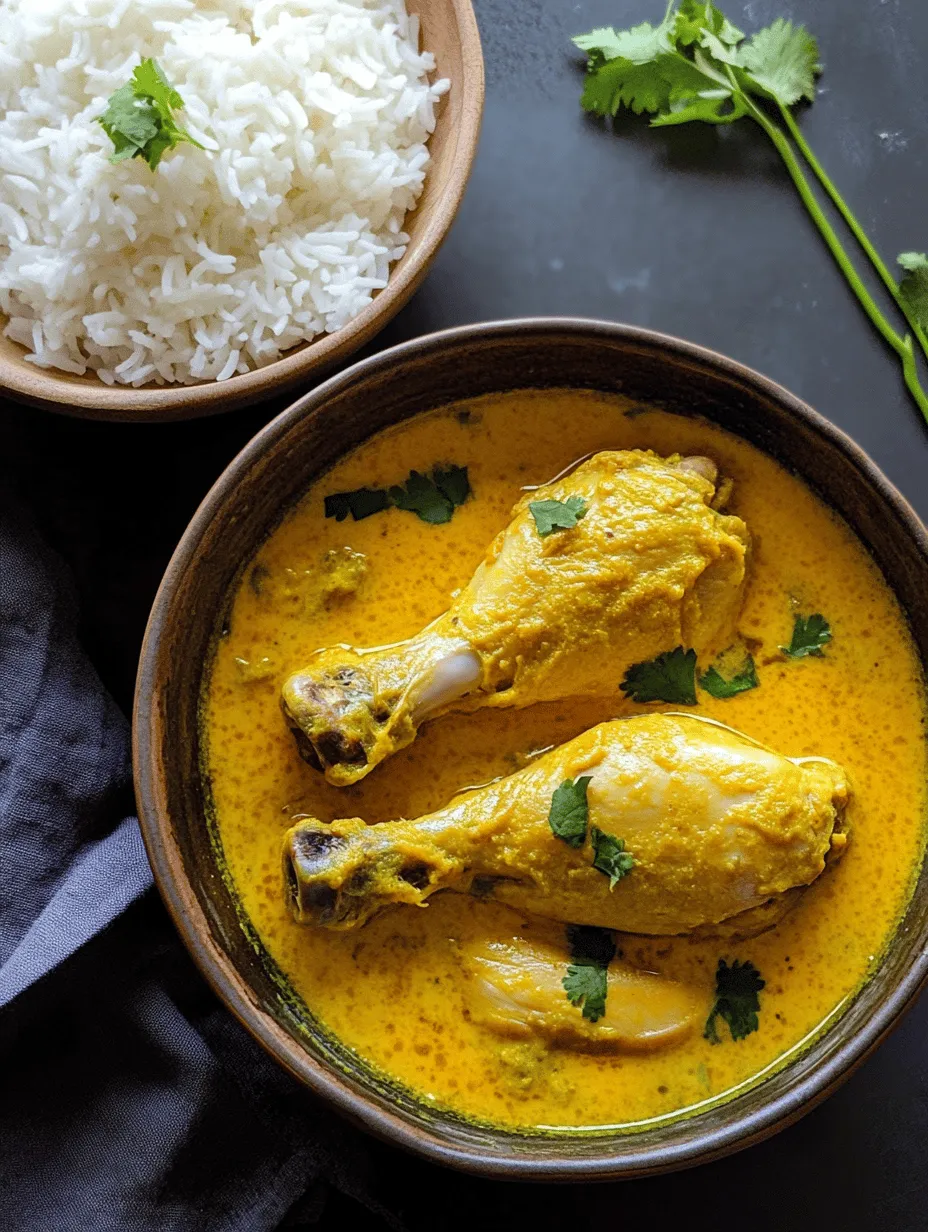Explore the rich culinary heritage of East Africa with Kuku Paka, a delightful coconut chicken dish that beautifully marries spices and flavors. Known for its creamy coconut base and aromatic spices, Kuku Paka is not only satisfying but also a celebration of vibrant culinary traditions. Whether you’re a seasoned home cook or a culinary novice, this dish promises to transport you straight to the shores of the Indian Ocean with its irresistible flavors and enticing aroma. This article will guide you through the origins of this dish, the health benefits of its ingredients, and provide a step-by-step recipe to create this comforting meal at home.
Understanding Kuku Paka: An Overview of Its Cultural Significance
Kuku Paka, often referred to as East Africa’s answer to coconut chicken curry, has its roots deeply embedded in the coastal regions of Kenya and Tanzania. The dish is a true reflection of the region’s rich history of trade and cultural exchange, bringing together influences from Arab, Indian, and local cuisines. This fusion is evident in the use of coconut milk, spices, and cooking techniques that have been passed down through generations.
The origins of Kuku Paka can be traced back to the Swahili coast, where coconut palms thrive and the tropical climate allows for a variety of spices to flourish. Here, the dish evolved as a staple for many coastal communities, often enjoyed during festive occasions and gatherings. The combination of chicken with coconut milk creates a hearty meal that is both nourishing and flavorful, making it a favorite among locals and visitors alike.
Coconut plays a pivotal role in East African cooking, not just in Kuku Paka but across a variety of dishes. It is adored for its rich, creamy texture and natural sweetness, which complements the spices used in cooking. The coconut palm is often referred to as the “tree of life” in many cultures because of its versatility – from its fruit used in cooking to its husk and leaves utilized in crafts and construction. In Kuku Paka, coconut milk serves as the base that ties all the flavors together, offering a luscious mouthfeel that enhances the overall dining experience.
Kuku Paka is more than just a dish; it symbolizes the cultural melting pot that is East Africa. The blend of spices such as turmeric, cumin, and coriander represents the historical trade routes that brought different cultures together. Each ingredient in Kuku Paka tells a story of the land, its people, and their culinary practices, making it a dish that resonates with history and heritage.
The Ingredients That Make Kuku Paka Unique
To create an authentic Kuku Paka, one needs to pay close attention to the ingredients. Each component adds its unique flavor and nutritional benefits, contributing to the dish’s appeal.
Chicken: Choosing the Right Cuts and Their Benefits
When it comes to making Kuku Paka, chicken is the star of the dish. Traditionally, bone-in, skin-on chicken pieces are preferred for their ability to retain moisture and flavor during cooking. Cuts such as thighs and drumsticks are particularly favored for their tenderness and rich taste. However, boneless chicken breast can also be used for a leaner version.
Chicken is an excellent source of protein, essential for muscle repair and growth. It also contains vital nutrients such as B vitamins, which play a crucial role in energy metabolism. When selecting chicken for Kuku Paka, look for fresh, high-quality cuts, preferably from free-range or organic sources, to ensure the best flavor and texture.
Coconut Milk: Nutritional Value and Taste Profile
Coconut milk is the heart of Kuku Paka, providing a creamy and luscious base that enhances the overall flavor. Made from the grated flesh of mature coconuts, coconut milk is rich in healthy fats, particularly medium-chain triglycerides (MCTs), which can provide quick energy and support weight management.
In terms of taste, coconut milk brings a subtle sweetness and a tropical flair that balances the spices used in the dish. It also helps to create a smooth sauce that clings to the chicken, ensuring every bite is bursting with flavor. When shopping for coconut milk, opt for canned or boxed varieties with minimal additives for the best taste and consistency.
Spices: The Importance of Turmeric, Cumin, Coriander, and Garam Masala
The spice blend used in Kuku Paka is what truly sets this dish apart. Key spices such as turmeric, cumin, coriander, and garam masala not only enhance the flavor but also offer numerous health benefits.
– Turmeric: Known for its anti-inflammatory properties, turmeric is a bright yellow spice that adds warmth and depth to the dish. Its active compound, curcumin, is believed to have antioxidant effects, making it a powerful addition to your diet.
– Cumin: This spice brings a slightly nutty and earthy flavor to Kuku Paka. Cumin is known to aid digestion and is rich in iron, making it an excellent choice for overall health.
– Coriander: Both the seeds and fresh leaves of coriander (cilantro) are used in Kuku Paka. The seeds add a citrusy, warm flavor, while the fresh leaves provide a burst of freshness. Coriander is also known for its digestive benefits and is rich in vitamins A and K.
– Garam Masala: A blend of various spices, garam masala adds complexity and warmth to the dish. It typically includes ingredients like cinnamon, cardamom, cloves, and nutmeg, each contributing to the aromatic profile of Kuku Paka. Garam masala is often added towards the end of cooking to preserve its vibrant flavors.
The Role of Fresh Herbs and Aromatics in Enhancing Flavor
In addition to spices, fresh herbs and aromatics play a crucial role in elevating the flavors of Kuku Paka. Ingredients like garlic, ginger, and green chilies are often sautéed at the beginning of the cooking process to create a fragrant base.
– Garlic: Known for its robust flavor and numerous health benefits, garlic adds depth and richness to the dish. It is believed to have antimicrobial properties and can support heart health.
– Ginger: This aromatic root adds a hint of spice and warmth, complementing the creaminess of coconut milk. Ginger is also known for its anti-inflammatory properties and can aid digestion.
– Green Chilies: For those who enjoy a bit of heat, green chilies can be adjusted according to personal preference. They provide a fresh kick that balances the richness of the coconut milk.
Together, these ingredients create a harmonious blend of flavors that make Kuku Paka a standout dish in East African cuisine.
Marinating the Chicken: The First Step to Flavorful Kuku Paka
Marinating the chicken is a crucial step in achieving a flavorful Kuku Paka. The marination process allows the spices to penetrate the meat, infusing it with flavor and ensuring that every bite is delicious.
Importance of Marinating Chicken for Flavor Infusion
Marinating chicken not only enhances its flavor but also helps to tenderize the meat, resulting in a juicy and succulent dish. The acidic components in the marinade, such as lemon juice or yogurt, help break down proteins, making the chicken more tender while the spices impart their unique flavors.
Suggested Marination Time and Alternative Spices for Variations
For optimal flavor infusion, it is recommended to marinate the chicken for at least 30 minutes. However, for best results, marinating overnight in the refrigerator allows the spices to deeply penetrate the meat. If you’re pressed for time, even a 15-minute marination can still yield delicious results.
While the traditional spice blend is essential for authentic Kuku Paka, you can also experiment with alternative spices to cater to your taste preferences. For instance, adding smoked paprika can introduce a subtle smokiness, while a dash of lime zest can elevate the dish with a refreshing citrus note.
Tips on How to Properly Marinate Chicken for Optimal Taste
To properly marinate chicken, follow these simple steps:
1. Combine Ingredients: In a mixing bowl, combine yogurt or coconut milk with spices, salt, and any additional flavorings like lemon juice or garlic. Stir until well mixed.
2. Coat the Chicken: Add the chicken pieces to the marinade, ensuring they are evenly coated. Use your hands to massage the marinade into the meat for better flavor absorption.
3. Cover and Refrigerate: Transfer the marinated chicken to a covered container or resealable plastic bag. Place it in the refrigerator and allow it to marinate for the recommended time.
4. Bring to Room Temperature: Before cooking, remove the chicken from the refrigerator and let it sit at room temperature for about 15 minutes. This helps the chicken cook evenly.
By taking the time to marinate the chicken properly, you set the foundation for a flavorful Kuku Paka that will delight your taste buds.
Sautéing Aromatics: Building the Flavor Base
Once your chicken is marinated and ready to go, the next step involves sautéing aromatics to build a robust flavor base for your Kuku Paka. This step is essential, as it creates the aromatic foundation that will elevate the dish to new heights.
The Art of Sautéing Onions to Achieve the Perfect Caramelization
Onions are often the first ingredient sautéed in the cooking process. To achieve the perfect caramelization, it’s essential to cook them over medium heat. Start by adding a generous amount of oil to a large skillet or saucepan, allowing it to heat up before adding finely chopped onions.
As the onions cook, they will gradually soften and turn golden brown. This caramelization process brings out their natural sweetness, which balances the spice elements in Kuku Paka. Stir them occasionally to prevent burning and achieve an even color. The goal is to reach a point where the onions are translucent with a rich, golden hue, enhancing the overall flavor profile.
How Garlic, Ginger, and Chilies Contribute to the Dish’s Depth
After the onions have caramelized, it’s time to add minced garlic, grated ginger, and chopped green chilies to the pan. These aromatics infuse the oil with their distinct flavors, creating a fragrant base that will enhance the chicken and coconut milk mixture.
– Garlic: As it cooks, garlic releases its pungent aroma, which adds depth to the dish. Be careful not to overcook the garlic, as it can become bitter if browned too much.
– Ginger: Fresh ginger brings a warm and slightly spicy note that complements the richness of the coconut milk. Its bright flavor cuts through the creaminess, resulting in a well-balanced dish.
– Green Chilies: The amount of green chilies can be adjusted based on your heat preference. They add a fresh, vibrant kick that elevates the overall flavor, while also providing a pop of color.
By carefully sautéing these ingredients, you set the stage for a deeply flavorful Kuku Paka that will leave a lasting impression on your palate.
In the following sections, we will explore the remaining steps to complete this delightful dish, but for now, take your time with these initial preparations. The patience and care you invest will shine through in the final taste of your Kuku Paka.

Balancing Flavors: Adjusting Spice Levels to Suit Your Palate
When making Kuku Paka, achieving the right balance of spices is essential to cater to individual tastes. The beauty of this dish lies in its versatility, allowing you to adjust spice levels based on your preferences. If you prefer a milder flavor profile, consider reducing the amount of chili powder or fresh chilies used. Conversely, for those who enjoy a fiery kick, feel free to add extra chili or even some crushed red pepper flakes to the mix.
Taste-testing during the cooking process is key. Start by adding smaller amounts of spices and gradually increase, letting the flavors meld before making further adjustments. This method not only helps you control the heat but also allows you to appreciate the depth of flavors developing in the sauce. Remember, Kuku Paka is a dish meant to be enjoyed, so don’t hesitate to experiment until you find that perfect balance that suits your palate.
Cooking the Chicken: Creating the Perfect Texture
The journey to a perfect Kuku Paka begins with the chicken. Browning the chicken is a crucial step that enhances not only the flavor but also the overall texture of the dish. For optimal browning, heat a generous amount of oil in a large skillet over medium-high heat. Once the oil is shimmering, add the chicken pieces skin-side down. Resist the urge to move them around too much; let them sear for about 5-7 minutes until they develop a beautiful golden-brown crust. This caramelization adds a depth of flavor that is signature to Kuku Paka.
Once the chicken is browned, it’s time to understand the cooking process. After browning, remove the chicken and set it aside, then add your aromatic ingredients like onions, garlic, and ginger to the same pan. This allows the flavors from the chicken to infuse into the aromatics, creating a robust base for your sauce. After sautéing the aromatics until they are soft and fragrant, return the chicken to the pan.
Temperature control is paramount during this stage. Keep the heat at medium to ensure that the chicken cooks evenly without burning the aromatics. Once the chicken is simmering in the sauce, ensure it reaches an internal temperature of 165°F (75°C) to guarantee that it is fully cooked yet still juicy and tender.
Crafting the Kuku Paka Sauce: A Harmony of Flavors
Building the Kuku Paka sauce is where the dish truly comes to life. Begin by adding tomato paste to the sautéed aromatics. This ingredient serves as a foundation for the sauce, providing both sweetness and acidity. Stir the tomato paste in for a minute or two, allowing it to caramelize slightly, which enhances its natural sweetness.
Next, it’s time to add the spices, including curry powder and cumin. These spices should be combined with the tomato paste and aromatics, allowing them to toast briefly, which will intensify their flavors. Once fragrant, pour in a mixture of coconut milk and chicken broth. The coconut milk brings creaminess to the dish while the broth adds depth and richness.
For the perfect sauce consistency, aim for a smooth, velvety texture. If the sauce appears too thick, gradually add more chicken broth until you reach your desired consistency. If it’s too thin, let it simmer uncovered for a few extra minutes to allow some of the liquid to evaporate.
As the sauce simmers, be sure to taste and adjust seasoning as needed. A pinch of salt and a squeeze of fresh lime juice can elevate the flavors, adding brightness to the dish.
Serving Suggestions: The Best Accompaniments for Kuku Paka
Kuku Paka is a dish best enjoyed with traditional East African sides. Steamed rice is a common accompaniment, as it absorbs the delicious coconut sauce beautifully. You could also opt for chapati, a soft, flat bread that is perfect for scooping up the chicken and sauce. Both options provide a comforting base that complements the rich flavors of Kuku Paka.
For a twist, consider serving Kuku Paka with alternative side dishes such as quinoa or a simple green salad. The nutty flavor of quinoa pairs well with the dish, while a salad can add a refreshing contrast to the creamy sauce.
Presentation plays a vital role in enhancing the dining experience. Serve Kuku Paka in a large, shallow dish, garnished with freshly chopped cilantro or parsley for a pop of color. A squeeze of lime over the top just before serving can also elevate the dish, adding a fresh zing that cuts through the richness of the sauce.
Health Benefits of Kuku Paka: Nourishing Your Body and Soul
Kuku Paka is not just a delight for the taste buds; it also offers several health benefits thanks to its wholesome ingredients. The primary ingredients—chicken, coconut milk, and spices—are packed with nutrients.
Chicken is a great source of lean protein, essential for muscle maintenance and overall health. It also contains important vitamins and minerals, such as B vitamins, which are vital for energy metabolism.
Coconut milk, while creamy and delicious, also has health benefits. It contains medium-chain triglycerides (MCTs), which are known to support weight management and provide a quick source of energy. Additionally, coconut milk is rich in vitamins C, E, and several B vitamins, contributing to a healthy immune system.
The spices used in Kuku Paka—such as turmeric and cumin—are known for their anti-inflammatory properties. Turmeric, in particular, contains curcumin, which has been studied for its potential health benefits, including enhancing brain function and reducing the risk of chronic diseases.
When considering Kuku Paka in the context of a balanced diet, it is important to pair it with nutritious sides, such as whole grains and vegetables, to create a well-rounded meal. With its combination of flavors and health benefits, Kuku Paka is a dish that nourishes both body and soul.
Conclusion: Embracing the Flavors of Kuku Paka
Kuku Paka is more than just a meal; it’s a culinary journey that brings together rich flavors and vibrant traditions. With its creamy coconut sauce, aromatic spices, and tender chicken, this dish is perfect for family gatherings or a comforting weeknight dinner. By following this recipe, you can enjoy a slice of East African culture in your own home, celebrating the joys of cooking and sharing delicious food with loved ones.
As you embark on your Kuku Paka cooking adventure, remember that the beauty of this dish lies in its adaptability. Feel free to experiment with the spice levels, side dishes, and presentation to make it your own. Whether you’re serving it for a special occasion or a simple family meal, Kuku Paka is sure to impress and become a beloved addition to your culinary repertoire. Enjoy the process, savor the flavors, and relish in the experience of creating this delightful dish that brings people together.



